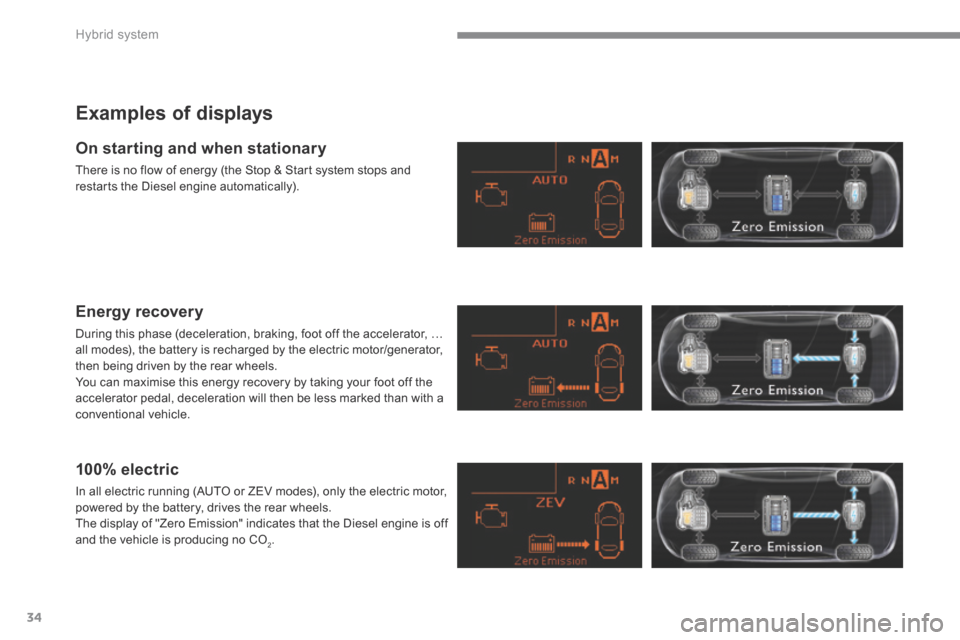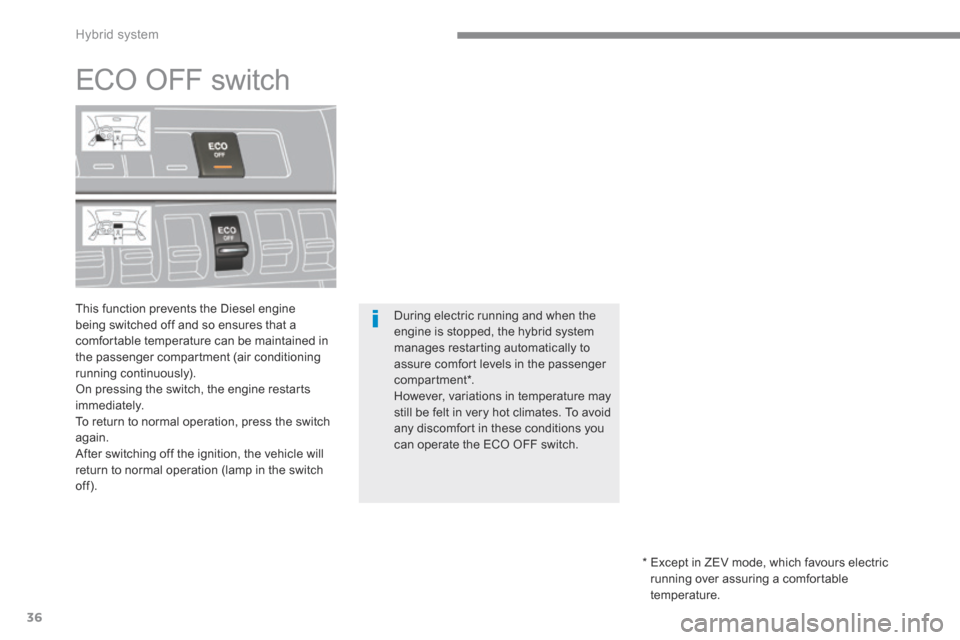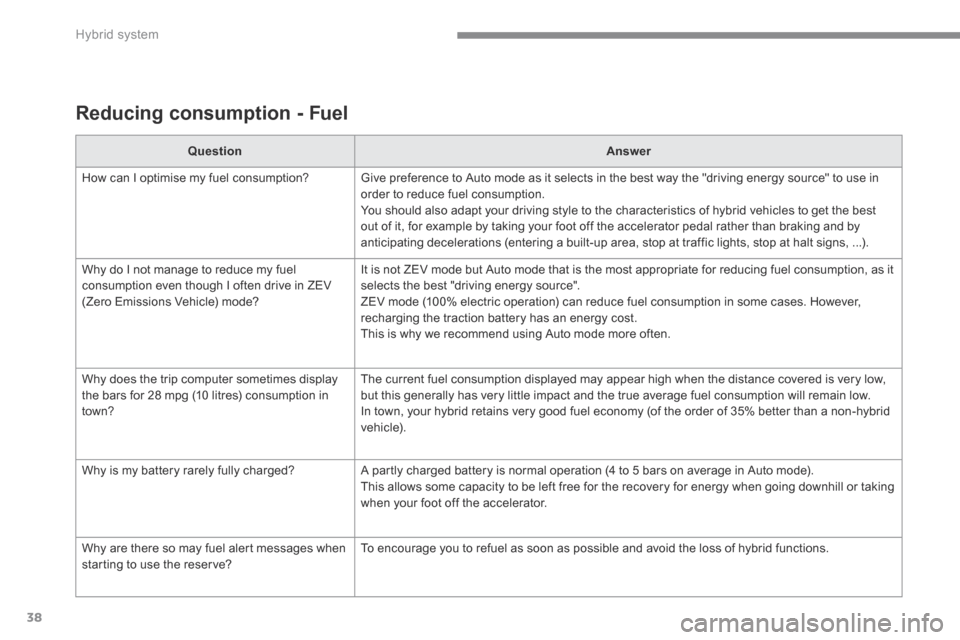2014 Peugeot 3008 Hybrid 4 stop start
[x] Cancel search: stop startPage 6 of 378

24
Familiarisation
4
Presentation of the HYbrid4 system
Thank you for choosing a 3008 HYbrid4; this vehicle has characteristics that are different from conventional vehicles. Study this handbook to learn about the specific hybrid functions and for more information, refer to the "Hybrid System" section.
The HYbrid4 technology allows two sources of energy to be associated in an effective manner: the Diesel HDi engine, which drives the front wheels and the electric motor, which drives the rear wheels. These two motors can operate alternately or simultaneously, according to the hybrid mode selected and the driving conditions. The electric motor alone provides power for
the vehicle in "ZEV " (Zero Emissions Vehicle) mode, and in "Auto" mode for running at slow speed and low load. It also assists the Diesel engine when moving off, accelerating and changing gear. The battery that powers the electric motor is recharged during phases of deceleration and stores the energy for subsequent use.
1. Diesel HDi engine (front wheel drive).
2. Electric motor (rear wheel drive). 3. 200 V battery. 4. Electronic power supervisor.
5. Alternator-starter motor (Stop & Start).
6. Electronic gearbox. 7. Electrical flow. 8. HYbrid4 mode selector.
Page 26 of 378

Hybrid system
24
Presentation
The HYbrid4 technology allows two sources of energy to be associated in an effective manner: the Diesel HDi engine, which drives the front wheels and the electric motor, which drives the rear wheels. These two motors can operate alternately or simultaneously, according to the hybrid mode selected and the driving conditions. The electric motor alone provides power for the vehicle in "ZEV " (Zero Emissions Vehicle) mode, and in "Auto" mode for running at slow speed and low load. It also assists the Diesel engine when moving off, accelerating and changing gear. The battery that powers the electric motor is recharged during phases of deceleration and stores the energy for subsequent use.
1. Diesel HDi engine (front wheel drive). 2. Electric motor (rear wheel drive). 3. 200 V battery. 4. Electronic power supervisor.
5. Alternator-starter motor (Stop & Start). 6. Electronic gearbox. 7. Electrical flow. 8. HYbrid4 mode selector.
Page 27 of 378

.Hybrid system25
Main parts of the HYbrid4 system
The HDi Diesel engine - 1 , located at the front, drives the front wheels and provides most of the power needed to drive the vehicle. It is fitted with an alternator-starter motor ( alternator-starter motor ( alternator-starter motorStop & Star t ) - 5 which recharges the batteries and provides additional power when needed (in 4x4 mode).
The electric motor - 2 , located at the rear, drives the rear wheels on its own, or supplements the Diesel engine, according to the hybrid mode selected. It recovers energy and charges the batteries during phases of deceleration of the vehicle and is
active up to 70 mph (120 km/h).
A 200 V NI-MH high voltage batter y - 3 , provides a source of energy for the rear electric motor. Its charging rate is managed automatically by the vehicle during phases of deceleration. It is located in a compartment in the boot, access to which is restricted to trained service technicians.
The battery state of charge is indicated by 8 horizontal or vertical bars (depending on the screen).
The conventional battery , located under the bonnet, powers the vehicle's 12 V systems. It is conventional battery , located under the bonnet, powers the vehicle's 12 V systems. It is conventional batteryrecharged automatically by the high voltage network.
Page 28 of 378

Hybrid system
26
The electronic power super visor - 4 automatically manages the operation of the two power units (Diesel and electric) to provide the lowest consumption. An inverter and a transformer are needed to manage the electric power. The inverter acts on the torque of the electric motor, by regulating the current coming from the high voltage battery pack. Its operating range is between 150 and 270 volts. The transformer converts the 200 V of the battery pack to 12 V, to power the vehicle's ancillary systems.
The alternator-starter motor - 5 assures the Stop & Star t function which allows the Diesel engine to be put into standby during stops (traffic lights, a stop, or in a traffic jam, for example) or during phases of running in all-electric mode. The stopping and restarting of the Diesel engine is done in a way that is instantaneous and transparent for the driver. It also provides additional charging of the batteries (4x4 mode for example or under-charged high voltage battery).
The electronic gearbox - 6 provides, in automatic mode, significant savings in fuel consumption compared to a conventional manual gearbox, thanks to its electronic control system. It also offers improved driving pleasure with the possibility at any time of choosing the gear changing mode: automatic or manual, using the paddles located behind the steering wheel.
Page 30 of 378

Hybrid system
28
With the gear selector in position N , press the brake pedal and start the hybrid system. This lamp comes on when the vehicle is ready to move off ("Auto" mode is on by default) and so the driver can press the accelerator. This lamp comes on more or less instantly but may take a few seconds in some cases (in particular, the time needed for pre-heating the Diesel engine in cold weather or in energy economy mode, for example, ...).
Ready lamp
How to switch off your
vehicle and the hybrid
system
- Apply the brake until the vehicle comes to a complete stop. - Place the gear lever in position N . - Turn the ignition key to position 1 , the parking brake is applied automatically if configured to do so. - Other wise apply the parking brake manually, the P warning lamp must be on.
When your vehicle star ts in electric mode, this means that it makes no noise. Be ver y careful of pedestrians as they will not hear you coming.
When stationary, switch off the ignition and ensure that the Ready lamp is off before you leave the vehicle, otherwise the hybrid system will still be active.
For more information, refer to the "Underbonnet precautions / warnings" section.
When stationary, switch off the hybrid system and check that the Ready lamp is off when you leave the vehicle, otherwise the hybrid system will remain active.
For more information, refer to the "Underbonnet precautions / warnings" section.
Page 36 of 378

Hybrid system
34
Examples of displays
On starting and when stationary
There is no flow of energy (the Stop & Start system stops and restarts the Diesel engine automatically).
Energy recovery
During this phase (deceleration, braking, foot off the accelerator, … all modes), the battery is recharged by the electric motor/generator, then being driven by the rear wheels. You can maximise this energy recovery by taking your foot off the accelerator pedal, deceleration will then be less marked than with a conventional vehicle.
100% electric
In all electric running (AUTO or ZEV modes), only the electric motor, powered by the battery, drives the rear wheels. The display of "Zero Emission" indicates that the Diesel engine is off
and the vehicle is producing no CO2.
Page 38 of 378

Hybrid system
36
ECO OFF switch
This function prevents the Diesel engine being switched off and so ensures that a comfortable temperature can be maintained in the passenger compartment (air conditioning running continuously). On pressing the switch, the engine restarts immediately. To return to normal operation, press the switch again. After switching off the ignition, the vehicle will return to normal operation (lamp in the switch off).
* Except in ZEV mode, which favours electric running over assuring a comfortable temperature.
During electric running and when the engine is stopped, the hybrid system manages restarting automatically to assure comfort levels in the passenger compartment * . However, variations in temperature may still be felt in very hot climates. To avoid any discomfort in these conditions you
can operate the ECO OFF switch.
Page 40 of 378

Hybrid system
38
Reducing consumption - Fuel
QuestionAnswer
How can I optimise my fuel consumption? Give preference to Auto mode as it selects in the best way the "driving energy source" to use in order to reduce fuel consumption. You should also adapt your driving style to the characteristics of hybrid vehicles to get the best out of it, for example by taking your foot off the accelerator pedal rather than braking and by anticipating decelerations (entering a built-up area, stop at traffic lights, stop at halt signs, ...).
Why do I not manage to reduce my fuel consumption even though I often drive in ZEV (Zero Emissions Vehicle) mode?
It is not ZEV mode but Auto mode that is the most appropriate for reducing fuel consumption, as it selects the best "driving energy source". ZEV mode (100% electric operation) can reduce fuel consumption in some cases. However, recharging the traction battery has an energy cost. This is why we recommend using Auto mode more often.
Why does the trip computer sometimes display the bars for 28 mpg (10 litres) consumption in town?
The current fuel consumption displayed may appear high when the distance covered is very low, but this generally has very little impact and the true average fuel consumption will remain low. In town, your hybrid retains very good fuel economy (of the order of 35% better than a non-hybrid vehicle).
Why is my battery rarely fully charged? A partly charged battery is normal operation (4 to 5 bars on average in Auto mode). This allows some capacity to be left free for the recovery for energy when going downhill or taking when your foot off the accelerator.
Why are there so may fuel alert messages when starting to use the reserve? To encourage you to refuel as soon as possible and avoid the loss of hybrid functions.